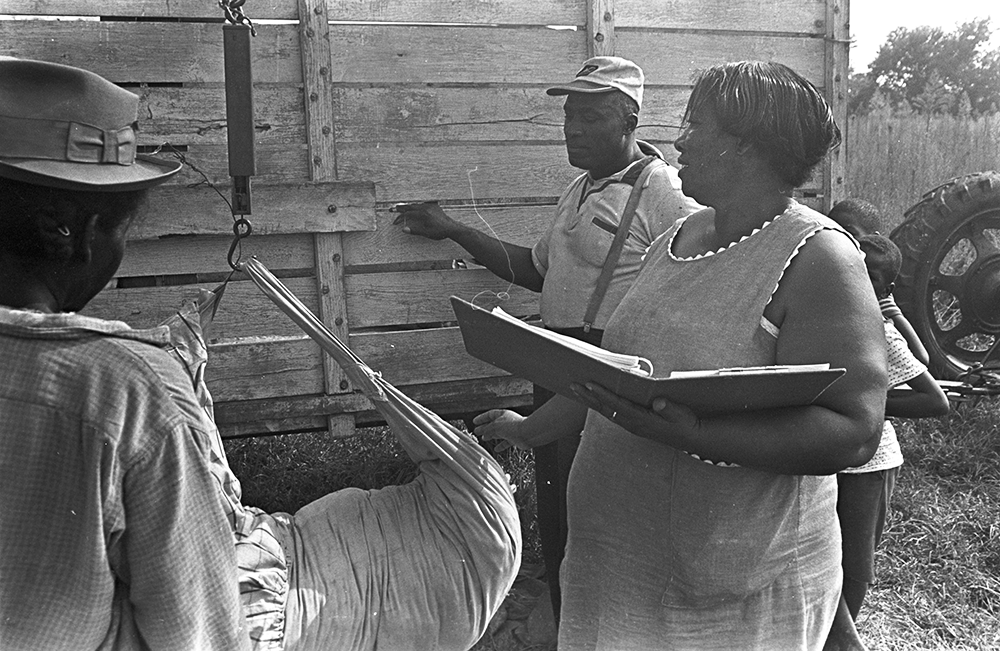Introduction: Labor and Land
Minnie B. Guice making notes in a book while a bag of cotton is being weighed at her farm near Mount Meigs in Montgomery County, Alabama. © Alabama Department of Archives and History, Jim Peppler Southern Courier photograph collection
Out of the 10 demands at the 1963 March on Washington, how many had to do with labor rights? This is one of the questions in our March on Washington mythbuster quiz. Seldom do people predict that the answer is five. As Bill Fletcher describes in Claiming and Teaching the 1963 March on Washington, half of the demands were not about integration or education — they were about labor and economic rights. It was the March on Washington for Jobs and Freedom. Ask students what cause Dr. Martin Luther King was supporting in Memphis when he was murdered. How many will say for integration? How many will know King was there to support a labor strike by Black sanitation workers?
Labor and land have always been central to the struggle for civil and human rights in the United States. In this introduction we share just a few examples, beginning with the fight by Native Americans to retain access to their land, a struggle that continues today with the violation by the U.S. government of treaties and the environmental devastation of Native lands. Introduce students to the Standing Rock Sioux Tribe fight to block the Dakota Access Pipeline.
While treated as separate topics in U.S. history classes, the Industrial Revolution and slavery are intertwined. Sven Beckert and Seth Rockman explain in Slavery's Capitalism: A New History of American Economic Development that the Industrial Revolution was fueled by the products and profits of enslaved labor. A central demand by freed African Americans during Reconstruction was for 40 acres and a mule.
Following Reconstruction, the convict labor system used a loophole in the 13th Amendment to provide free labor for large landowners and state governments, as the films Slavery by Another Name and 13th bring to light. The labor was brutal and dangerous. For example, in 1911, 128 men, almost all of them African Americans and prisoners of the state (convict laborers), were killed in the Banner Mine explosion in Alabama.
When workers developed solidarity across racial lines, they faced severe repression because they threatened the ability of those in power to “divide and conquer.” One example was the Southern Tenant Farmers Union, a union of Black and white sharecroppers in the 1930s, described in a lesson (online) by Bill Bigelow and Norm Diamond.
Throughout her life, SNCC co-founder and mentor Ella Baker connected civil rights to economic and land rights. She led consumer boycotts and worked to develop consumer cooperatives in the 1930s and 1940s.
Traditional textbooks tend to describe women in the workforce starting with Rosie the Riveter during World War II and limit women in labor organizing to Mother Jones. This leaves out the role of working women of color throughout U.S. history and labor organizers such as Emma Tenayuca in San Antonio and Shirley Sherrod’s work with Black farmer co-operatives in Georgia.
Black farmers who secured land during the New Deal were able to support Mississippi voting rights activists in the 1960s with safe havens, collateral for jail bonds, armed protection, and locations for Freedom Schools. Introduce students to the interconnection of Black land ownership and political power with the film Dirt and Deeds in Mississippi. We include teaching ideas for this film in this chapter.
In Looking for Justice at Turkey Creek: Out of the Classroom and into the Past, Mississippi teacher Hardy Thames describes how the fight for Black landownership continues, along with the fight for environmental justice.
While labor organizing is absent in the traditional narrative of Black history, labor organizer Cesar Chavez is the one name most students learn in Latino history. However, Chavez and the United Farmworkers are presented in isolation of the long history of Mexican immigrant labor and resistance, including contract labor during WWI and the Bath Riots in protest of the fumigation of Mexican workers as they crossed the border. Also missing is the story of the Filipino workers and labor leaders who launched the precursor to the UFW and the African Americans who marched in solidarity. (See To March for Others: The Black Freedom Struggle and the United Farm Workers.)
Asian Americans encountered similar barriers to housing and human rights. In Alien Neighbors, Foreign Friends: Asian Americans, Housing and the Transformation of Urban California, Charlotte Brooks brings to light the effect of federal and city policy on Asian Americans in California, noting that, “San Francisco’s Chinatown was America’s first segregated neighborhood.” When Chinese Americans worked on the transcontinental railroad, they were underpaid and poorly treated. They faced racial terrorism such as in the 1885 Rock Springs Massacre in Wyoming. Such backlash was part of a national campaign, culminating in the Chinese Exclusion Act of 1882.
Land issues extend to the North. Textbooks often describe Northern housing segregation as de facto or voluntary. In fact, racial segregation and inequality were enforced through housing covenants and redlining. Richard Rothstein describes Northern dejure segregation in Our House Divided: What U.S. Schools Don’t Teach About U.S.-Style Apartheid.
The federal government suppressed the struggle for economic and labor rights. Any study of the McCarthy era and the House Un-American Activities Committee should reveal how the real target was the labor movement and the Black Freedom Struggle, with the threat of “communists” used to generate fear and compliance. This carried on into the 1960s and 1970s with COINTELPRO and continues today with attacks on “CRT” to suppress honest instruction about U.S. history and racism.
After engaging with the readings and lessons in this section, students will be better prepared to discuss the issue of reparations. They can read the interview with Ta-Nehisi Coates and design their own bill, using the lesson Repair: Students Design a Reparations Bill by Ursula Wolfe-Rocca. ■

